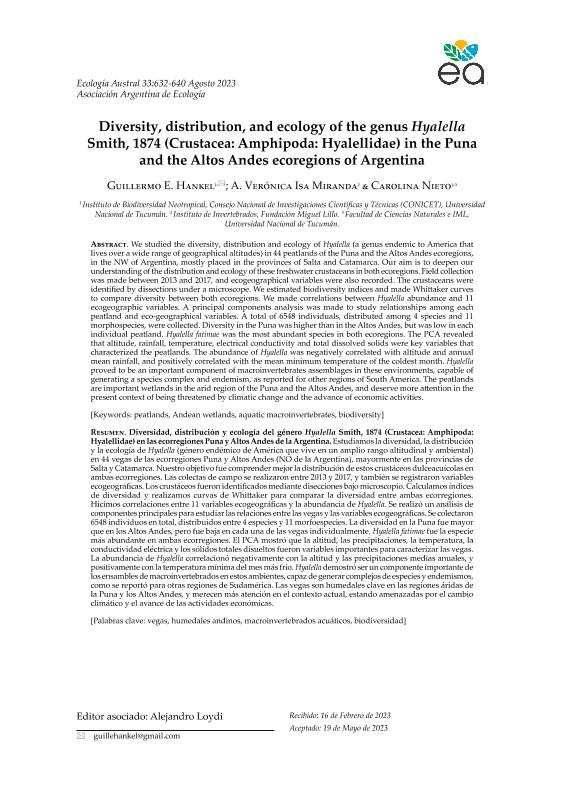Mostrar el registro sencillo del ítem
dc.contributor.author
Hankel, Guillermo Eduardo

dc.contributor.author
Isa Miranda, Agueda Veronica

dc.contributor.author
Nieto, Carolina
dc.date.available
2024-01-09T12:55:48Z
dc.date.issued
2023-07
dc.identifier.citation
Hankel, Guillermo Eduardo; Isa Miranda, Agueda Veronica; Nieto, Carolina; Diversity, distribution, and ecology of the genus HyalellaSmith, 1874 (Crustacea: Amphipoda: Hyalellidae) in the Puna and the Altos Andes ecoregions of Argentina; Asociación Argentina de Ecología; Ecología Austral; 33; 2; 7-2023; 632-640
dc.identifier.issn
0327-5477
dc.identifier.uri
http://hdl.handle.net/11336/222967
dc.description.abstract
Estudiamos la diversidad, la distribución y la ecología de Hyalella (género endémico de América que vive en un amplio rango altitudinal y ambiental) en 44 vegas de las ecorregiones Puna y Altos Andes (NO de la Argentina), mayormente en las provincias de Salta y Catamarca. Nuestro objetivo fue comprender mejor la distribución de estos crustáceos dulceacuícolas en ambas ecorregiones. Las colectas de campo se realizaron entre 2013 y 2017, y también se registraron variables ecogeográficas. Los crustáceos fueron identificados mediante disecciones bajo microscopio. Calculamos índices de diversidad y realizamos curvas de Whi�aker para comparar la diversidad entre ambas ecorregiones. Hicimos correlaciones entre 11 variables ecogeográficas y la abundancia de Hyalella. Se realizó un análisis de componentes principales para estudiar las relaciones entre las vegas y las variables ecogeográficas. Se colectaron 6548 individuos en total, distribuidos entre 4 especies y 11 morfoespecies. La diversidad en la Puna fue mayor que en los Altos Andes, pero fue baja en cada una de las vegas individualmente. Hyalella fatimae fue la especie más abundante en ambas ecorregiones. El PCA mostró que la altitud, las precipitaciones, la temperatura, la conductividad eléctrica y los sólidos totales disueltos fueron variables importantes para caracterizar las vegas. La abundancia de Hyalella correlacionó negativamente con la altitud y las precipitaciones medias anuales, y positivamente con la temperatura mínima del mes más frío. Hyalella demostró ser un componente importante de los ensambles de macroinvertebrados en estos ambientes, capaz de generar complejos de especies y endemismos, como se reportó para otras regiones de Sudamérica. Las vegas son humedales clave en las regiones áridas de la Puna y los Altos Andes, y merecen más atención en el contexto actual, estando amenazadas por el cambio climático y el avance de las actividades económicas.
dc.description.abstract
We studied the diversity, distribution and ecology of Hyalella (a genus endemic to America that lives over a wide range of geographical altitudes) in 44 peatlands of the Puna and the Altos Andes ecoregions, in the NW of Argentina, mostly placed in the provinces of Salta and Catamarca. Our aim is to deepen our understanding of the distribution and ecology of these freshwater crustaceans in both ecoregions. Field collection was made between 2013 and 2017, and ecogeographical variables were also recorded. The crustaceans were identified by dissections under a microscope. We estimated biodiversity indices and made Whittaker curves to compare diversity between both ecoregions. We made correlations between Hyalella abundance and 11 ecogeographic variables. A principal components analysis was made to study relationships among each peatland and eco-geographical variables. A total of 6548 individuals, distributed among 4 species and 11 morphospecies, were collected. Diversity in the Puna was higher than in the Altos Andes, but was low in each individual peatland. Hyalella fatimae was the most abundant species in both ecoregions. The PCA revealed that altitude, rainfall, temperature, electrical conductivity and total dissolved solids were key variables that characterized the peatlands. The abundance of Hyalella was negatively correlated with altitude and annual mean rainfall, and positively correlated with the mean minimum temperature of the coldest month. Hyalella proved to be an important component of macroinvertebrates assemblages in these environments, capable of generating a species complex and endemism, as reported for other regions of South America. The peatlands are important wetlands in the arid region of the Puna and the Altos Andes, and deserve more atention in the present context of being threatened by climatic change and the advance of economic activities.
dc.format
application/pdf
dc.language.iso
spa
dc.publisher
Asociación Argentina de Ecología

dc.rights
info:eu-repo/semantics/openAccess
dc.rights.uri
https://creativecommons.org/licenses/by/2.5/ar/
dc.subject
ANDEAN WETLANDS
dc.subject
AQUATIC MACROINVERTEBRATES
dc.subject
BIODIVERSITY
dc.subject
PEATLANDS
dc.subject.classification
Ecología

dc.subject.classification
Ciencias Biológicas

dc.subject.classification
CIENCIAS NATURALES Y EXACTAS

dc.title
Diversity, distribution, and ecology of the genus HyalellaSmith, 1874 (Crustacea: Amphipoda: Hyalellidae) in the Puna and the Altos Andes ecoregions of Argentina
dc.title
Diversidad, distribución y ecología del género Hyalella Smith, 1874 (Crustacea: Amphipoda: Hyalellidae) en las ecorregiones Puna y Altos Andes de la Argentina
dc.type
info:eu-repo/semantics/article
dc.type
info:ar-repo/semantics/artículo
dc.type
info:eu-repo/semantics/publishedVersion
dc.date.updated
2024-01-09T10:10:18Z
dc.journal.volume
33
dc.journal.number
2
dc.journal.pagination
632-640
dc.journal.pais
Argentina

dc.description.fil
Fil: Hankel, Guillermo Eduardo. Consejo Nacional de Investigaciones Científicas y Técnicas. Centro Científico Tecnológico Conicet - Tucumán. Instituto de Biodiversidad Neotropical. Universidad Nacional de Tucumán. Facultad de Ciencias Naturales e Instituto Miguel Lillo. Instituto de Biodiversidad Neotropical. Instituto de Biodiversidad Neotropical; Argentina
dc.description.fil
Fil: Isa Miranda, Agueda Veronica. Fundación Miguel Lillo. Dirección de Zoología. Instituto de Invertebrados; Argentina. Consejo Nacional de Investigaciones Científicas y Técnicas. Centro Científico Tecnológico Conicet - Tucumán; Argentina
dc.description.fil
Fil: Nieto, Carolina. Consejo Nacional de Investigaciones Científicas y Técnicas. Centro Científico Tecnológico Conicet - Tucumán. Instituto de Biodiversidad Neotropical. Universidad Nacional de Tucumán. Facultad de Ciencias Naturales e Instituto Miguel Lillo. Instituto de Biodiversidad Neotropical. Instituto de Biodiversidad Neotropical; Argentina
dc.journal.title
Ecología Austral

dc.relation.alternativeid
info:eu-repo/semantics/altIdentifier/url/https://ojs.ecologiaaustral.com.ar/index.php/Ecologia_Austral/article/view/2185
dc.relation.alternativeid
info:eu-repo/semantics/altIdentifier/doi/http://dx.doi.org/10.25260/EA.23.33.2.0.2185
Archivos asociados
